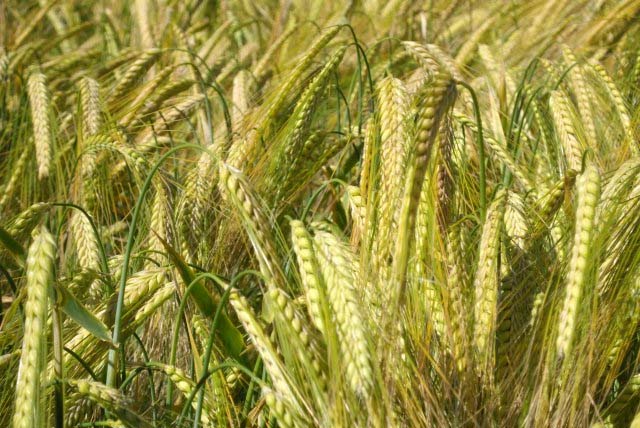
The total cereals and oilseeds harvest area in Great Britain has fallen by an estimated 4% on 2012 to just over 3.68 million hectares, according to the 2013 AHDB/HGCA Planting and Variety Survey published today.
As a result of the poor planting and growing conditions this year farmers were asked to submit their intended harvest area rather than planted area.
Total GB area dedicated to barley and oats has increased, while wheat and oilseed rape area has reduced, reflecting the poor planting conditions of last autumn and a switch to spring cropping.
GB wheat area is down 19% on 2012 at 1.61 million hectares, while total barley area is estimated to have increased 26% on 2012 figures at 1.23 million hectares.
Oilseed rape is estimated to be down 9% from 2012 levels at 686,000 hectares. Oats* have increased by 32% to 159,000 hectares, and the GB field bean* area has also increased by an estimated 14% to 109,000 hectares.
“This season has been the most severe since 2001 when set-aside was still in place,” said AHDB Senior Cereals and Oilseeds Analyst Jack Watts. “However, 12 years on with no set-aside to fall back on and relatively strong grain prices, the most economic scenario for the majority of growers has been to plant spring crops in place of what would have been winter crops.”
He added: “Yields still remain uncertain however, especially following the recent hot and dry conditions and ongoing concerns about soil compaction. For oilseed rape there has been a large variation in individual farmer approaches to the decision to abandon crops, so this estimated decrease in oilseed harvest area needs to be treated carefully.”
GB Wheat – Down 19% at 1.61 million ha
No region of GB appears to have escaped the fallout from the difficult planting conditions of 2012. The reduction in wheat harvest area ranges from a fall of 12% in Eastern England though to an estimated 26% drop in the South West. However in absolute terms the largest declines are seen in the East Midlands (a fall of 66,000 hectares), Eastern England (63,000 hectares) and Yorkshire (55,000 hectares).
In Scotland, the intended harvest area is estimated at 86,000 hectares, down 14% on 2012 with a comparable level not seen since 2003. However the wet autumn of 2012 followed a similar wet autumn for 2011 which reduced the Scottish wheat area. The estimated 86,000 hectares for 2013 is therefore a 25% drop on 2011 harvest area (115,000 hectares).
The low GB wheat area for this year makes it very likely the UK will remain a net importer of wheat in 2013/14 as it was in 2012/13.
“Although the fall in wheat harvest area is extreme, this is unlikely to come as a huge shock to the industry or the market which has been preparing for such a scenario for some time. Higher levels of carry over stock from the previous season may also partly offset the low level of production,” added Mr Watts.
Wheat variety share continues to evolve, with an estimated 56% of the GB wheat area down to nabim Group 4 varieties – an increase of 3% points on 2012. On farm economics are a key driver of this trend with farmers looking to capitalise on high feed base prices.
The share of nabim Group 1 varieties fell by 2% points to 14% (222,000 hectares) of intended harvest area for 2013 reflecting the low milling wheat premiums of late spring/early summer 2012 when variety decisions for 2013 were being made. For nabim Group 2 and Group 3 varieties, their share increased by 3% points to 12% (192,000 hectares) and decreased by 5% points to 15% (249,000 hectares) respectively.
GB Barley – 26% increase to 1.23 million hectares
Driving the GB barley harvest area is a 54% increase in spring barley to an estimated 922,000 hectares for 2013, with plantings in England forming the majority of the increase.
In Scotland, which accounts for a third of the GB spring barley area, harvest area has increased by 5% to 303,000 hectares. This, quality and yield depending, could provide much needed supply for the distilling sector.
In terms of variety make up, 73% of the GB area is estimated to be down to malting varieties – an increase of 6% points. However this may not feed through to an increase in malting availability at harvest as pass rates will be heavily influenced by germination and nitrogen content, which are driven by the growing and harvesting conditions.
GB Oilseed rape – down 9% to 686,000 hectares
2013 marks the end of a three year run where records have been set for the GB oilseed rape area. The impact of abandonment, delayed crop development and the current hot and dry conditions is difficult to predict. The survey suggests the GB winter oilseed rape area is down 19% on 2012. To a certain extent additional spring oilseed rape has offset some of the winter losses.
DK Cabernet remains the top oilseed rape variety, commanding 16% of the estimated harvest area – but this is down from 21% last year. PR46W21 climbs to second place with 10% of the estimated area – an increase from 5% last season.
Oats – increase by 32% to 159,000 hectares
The AHDB/HGCA Winter Planting Survey published in December 2012 suggested a 30% drop in the winter oat area compared to 2011. Potential factors driving the subsequent increase in spring plantings are increased oat milling demand, land free for cropping and available varieties - the spring oat variety Canyon was added to the Recommended List in 2011.
